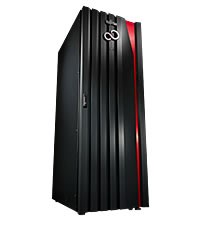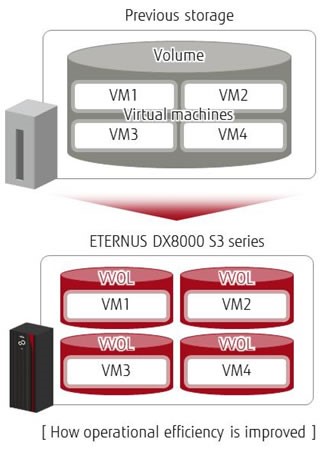Fujitsu Introduces the ETERNUS DX8000 S3 Series of Disk Storage Systems
BUY ONLINE |

Fujitsu products |
Fujitsu has announced the introduction of the FUJITSU Storage ETERNUS DX8000 S3 series.
Models in the ETERNUS DX8000 S3 series – the DX8700 S3 and DX8900 S3 – represent the pinnacle of Fujitsu's storage products, and are suited to a range of applications, whether maintaining or upgrading an existing enterprise system or building a new system for innovation from scratch.
In addition to Fujitsu's technologies for high reliability, the new series incorporates performance improvements that make I/O speeds roughly eight times faster than its predecessor, and achieves world-class processing performance, thereby supporting the stable operations of mission-critical enterprise systems and social infrastructure systems. The series supports the deployment and integration of storage for various business-oriented and information-oriented systems and improves operational efficiency due to improved responsiveness via new auto-tuning functionality and upgraded connection functions that make it easy to run backups and set up storage in virtual environments.
Background
With the spread of the Internet of Things, there is a need for new "systems of engagement," which are used to consolidate and analyze heterogeneous data, in addition to the existing "systems of record," which are used in enterprise systems to keep accurate records of the results of business processes. While systems of record will continue to be used and upgraded in the future, there will be a need to build new systems that can connect to systems of engagement to encourage new ways to use data.
Fujitsu is now offering the ETERNUS DX8000 S3 series, with significantly improved processing performance for diverse applications ranging from enterprise systems for business and social infrastructure systems to new types of systems designed for innovation that require flexibility.
Key Features of the ETERNUS DX8000 S3 Series
1. Outstanding processing performance for instant access to data
1) Improving controller performance and maximizing the number of controllers improves peak performance eight-fold compared to the previous model, achieving world-class levels of roughly 4 million IOPS. This outstanding processing performance ensures instant data utilization.
2) Newly added support for Extreme Cache, an SSD cache built into the controller using the latest flash technology, greatly increases the rate of cache hits on read operations, resulting in a four-fold performance improvement in an internal comparison. Using a large Extreme Cache alleviates loads at times of heavy access and can flexibly accommodate unpredictable changes in the environment.
2. New self-tuning functionality improves responsiveness, enabling flexible resource utilization
An automatic hierarchical-control function that redistributes data storage targets among disks and SSDs in response to access frequency is newly connected to a QoS function that automatically adjusts internal storage resource allocation in response to performance targets, improving responsiveness. When targeted responsiveness levels are not achieved using the QoS function's automatic tuning, data is redistributed to high-speed storage targets using the storage automatic hierarchical-control function, which boosts responsiveness. This provides required performance levels in diverse access environments without complex performance settings.
3. More efficient operations in virtual environments
Support has been added for VMware vSphere Virtual Volumes, which makes storage operations more efficient for virtualized server environments using the VMware vSphere virtualization platform. By simplifying storage settings, it had been the case that multiple virtual machines were stored in an equivalent storage volume and operated on a per-volume basis. This made backups and performance tuning for each virtual machine difficult. Using VMware vSphere Virtual Volumes makes it easy to set operations policies for virtual machines, such as backups and QoS, and using the vSphere Web Client interface storage operations can be optimized for the requirements of each virtual machine.

Specifications |
|||||||||||||||||||||||||||||||||||||||||||||||||||||||||||||||||||||||||||||||||||||||||||||||||||
|
TERNUS DX8700 S3 |
Physical capacity: 4,608 TB max Number of drives: 1,536 max Cache capacity: 1,024 GB max Controllers: 2-8 Compatible with: mainframes, open systems |
||||||||||||||||||||||||||||||||||||||||||||||||||||||||||||||||||||||||||||||||||||||||||||||||||
|
ETERNUS DX8900 S3 |
Physical capacity: 13,824 TB max Number of drives: 4,608 max Cache capacity: 6,144 GB max Controllers: 2-24 Compatible with: open systems |
||||||||||||||||||||||||||||||||||||||||||||||||||||||||||||||||||||||||||||||||||||||||||||||||||
For availability and pricing details please contact your dedicated account manager.

